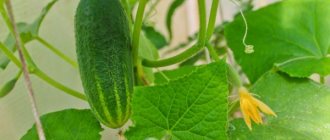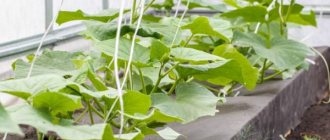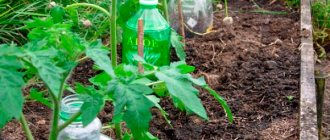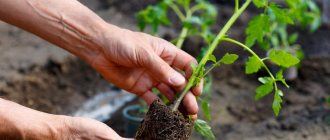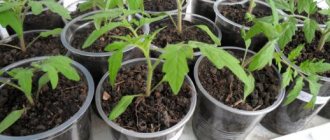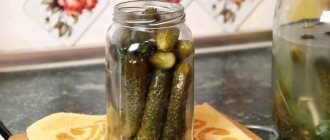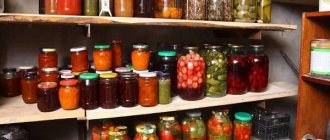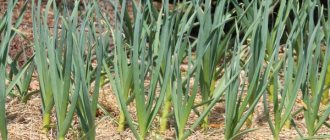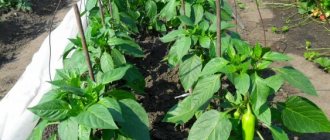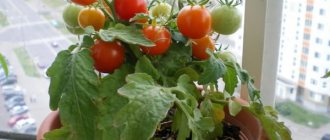How to plant cucumbers with seeds
Planting cucumbers in 5 liter bottles is not much different from other methods of sowing pumpkin crops. For the best harvest, you need to take seeds collected two to three years ago. Their pre-sowing treatment includes disinfection and soaking. Cucumber seeds can be disinfected using:
- potassium permanganate;
- table salt;
- copper sulfate.
A brightly colored solution of potassium permanganate is poured into the seeds and left for 10-15 minutes. If you use salt disinfection, take a teaspoon of salt or vitriol per glass of water. After disinfection, the seed material is thoroughly washed with clean water. Friendly shoots are obtained if, after treatment, the seeds are left moist for germination. Place them on a layer of wet cloth or paper, cover with another similar layer. If the seeds do not dry out, sprouts will appear by the third day.
How to care for a plant
The rules for caring for cucumbers in garden beds are almost no different from growing them at home. The plant will need to be watered more often, fed with nitrogen fertilizers and protected from pests.
Organization of watering and other requirements
Watering the plant during the fruiting period is carried out every 2-3 days. The procedure takes place early in the morning or in the evening, so the scorching sun will not burn the delicate foliage. To prevent a dry crust from forming on the surface, loosen the soil a few hours after moistening.
Plantings also need to be mulched using straw or sawdust. To avoid powdery mildew or root rot, the mound is changed regularly.
Applying timely fertilizers
For the first feeding of cucumbers in open ground, prepare a mixture of magnesium sulfate, superphosphate, and ammonium nitrate. Then, every two weeks, a solution of bird droppings or cow manure is used as fertilizer. To avoid damaging the foliage, the plant is fertilized using the root method.
Expert opinion
Stanislav Pavlovich
Gardener with 17 years of experience and our expert
Ask a Question
Once a week, the beds are watered with bread infusion. To do this, fill a third of the bucket with bread crusts, fill the mixture with water to the brim and leave it warm for 2 weeks. The resulting fertilizer is diluted with water (1:10) and the bushes are irrigated or 0.5 liters of fertilizer are poured into each bottle.
When to plant cucumbers in bottles
Planting cucumbers in 5 liter bottles is a technology that has two options. They have one thing in common: plastic containers become a miniature greenhouse for young plants. but the methods and time of planting seeds vary. Both methods are interesting and worthy of attention.
- In an apartment or heated greenhouse, seeds are sown in bottles for seedlings, which will later “move” to a garden bed or shelter.
- The seed is planted directly into the ground and grows under the bottles until the onset of stable heat.
The timing of planting depends on the choice of technology. Sowing in a garden bed under bottles is done in the same way as planting cucumbers in a greenhouse with seeds. The soil should be warmed to 13-15 degrees. If the year is favorable, then this ground temperature is established by the end of April, but in a long spring - two or three weeks later. These 15-20 days are enough to grow cucumber seedlings. If the bottles are to serve not only as shelter, but also as a nursery, the time for sowing seeds is shifted to mid-April.
Growing cucumbers in five-liter bottles at home
Planting cucumbers in plastic bottles has many advantages: firstly, such containers are compact and convenient to place indoors, secondly, the soil in transparent plastic warms up well, which has a positive effect on the root system of your plant, and thirdly, such The method is well suited for obtaining an early harvest. But there are some minor drawbacks. Bottles, unlike containers and boxes, are usually used once, so you'll have to stock them up again next year. Also keep in mind that one bottle is designed for only one plant, and if you don’t have enough space on your balcony, you won’t be able to grow many bushes.
Seed preparation
Since the conditions for growing cucumbers on the balcony are close to greenhouse conditions, cucumbers should be sown in mid-April. It is also advisable to select self-pollinating varieties (Aprelsky F1, Zozulya F1, Emelya F1, Matilda F1).
- Warming up. For a month before sowing, keep the seeds in a warm place at a temperature of + 25°C.
- Disinfection. Prepare a bright pink solution of potassium permanganate (mix 1 g of powder with 200 g of water) and place the seeds in it for 20–25 minutes. Then take it out, rinse in clean water and dry a little on a napkin.
- Soak. Place a moistened piece of cloth at the bottom of the container or plate, place the seeds on it and cover them with a second moistened piece of cloth. Place the workpiece in a warm place for 2 days, making sure that the fabric does not dry out.
To ensure better germination of seeds, they need to be treated before sowing.
If you bought seeds, then carefully study the packaging: many manufacturers themselves carry out the necessary seed treatment and indicate this. If you find such a mark, then do only soaking.
Sowing seeds
For growing you will need five liter bottles. You can sow 3-5 seeds in each bottle, but, as mentioned above, you will need to leave 1 strongest shoot. You can remove unnecessary sprouts when they form 2-3 true leaves.
- Cut off the top of the bottle 4–5 cm below the “shoulders” and make drainage holes at the bottom.
- Place 4–5 cm of drainage material (pea gravel, eggshells, sphagnum moss, etc.).
- Fill the bottle with soil, not reaching 2-3 cm to the top edge. You can take a ready-made universal vegetable mixture, but it is advisable to prepare the soil yourself: mix garden soil, compost, peat and sawdust in equal parts. It is also recommended to add ash to the soil (0.3 tbsp/kg of soil).
- Moisten the soil and make holes 3–5 cm deep in it.
- Carefully place 1 seed in each and sprinkle.
- Lightly moisten the crops with a spray bottle, cover with the cut top and place in a warm, bright place.
- Bottles can be moved to the balcony when the temperature on it is +22°C - +25°C.
To make a “greenhouse”, you need to remove the bottom of the bottle or make holes in it and cut off the top
You can also sow the seeds first in separate containers, and then transplant them into a bottle when the sprouts form 2-3 true leaves.
In order to obtain ordinary seedlings and then place them in open ground under a bottle, do the same, but sow in separate containers (peat cups work well) with a volume of 150–200 ml, and then cover them with film. Sowing time is mid-April.
Video: growing cucumbers in a bottle
Further care
To provide good conditions for cucumbers, you need to perform several simple care procedures.
Watering
It is carried out according to the following scheme: water young seedlings up to 20 days old once every 2 days, during the period before flowering - once every 5-7 days, and then every 3-4 days. In this case, it is necessary to use only warm (heated in the sun) water. Plants need to be watered at the root, avoiding moisture getting on the leaves. After each watering, do not forget to carefully loosen the soil to avoid crust formation and provide the roots with access to oxygen.
Ventilation
Try to ventilate the crops 2 times a day for 10 minutes, slightly moving the lid or film. Also remove condensation promptly. The covering material can be completely removed immediately after germination.
Lighting
Cucumbers are light-loving plants, so try to find a place on your balcony with good lighting. But keep in mind that direct sunlight at high temperatures can harm your plantings, so in such cases it is advisable to shade them.
Pollination
If you have selected a non-self-pollinating variety, you will have to carry out this procedure yourself. To do this, carefully examine the bush and find female flowers (they are located on a small green seal) and male ones. Carefully pluck or cut away the male flower and remove all the petals so that only the stamens remain, then gently pass them several times over the central structure of the female flower. Some gardeners do it even simpler: they collect pollen with a cotton swab and then transfer it to the desired place.
Female cucumber flowers are located on small seals
Top dressing
Since your plants are in containers with a limited amount of soil and therefore will not be able to get many nutrients from it, they will definitely need to be fed. Over the entire period of time, it is necessary to carry out 5 root feedings of your plant:
- The first feeding is carried out at the beginning of flowering. Ingredients: urea (1 tsp) + superphosphate (1 tsp) + potassium sulfate (1 tsp) + sodium humate (1 tbsp) + water (10 l).
- The second feeding is carried out 10–12 days after the first. Ingredients: potassium sulfate (1 tsp) + sodium humate (instead you can take the nutritional composition Ideal, Fertility, Breadwinner - 2 tbsp) + water (10 l).
- The third and subsequent feedings have the same composition as the second and are carried out once every 10–12 days.
Do not forget that it is necessary to add nutrient compositions to pre-moistened soil.
In addition to root feeding, cucumbers will also benefit from spraying:
- The first feeding is carried out at the beginning of flowering. Ingredients: urea (1 tsp) + water (1 l).
- The second feeding is carried out at the beginning of fruiting. Ingredients: urea (1/3 tsp) + water (1 l).
- The third feeding is carried out when the yield declines. Ingredients: urea (1/4 tsp) + water (1 l).
Bush formation
This event includes gartering, pinching and pinching.
Recent Entries
5 working ways to use tar in the garden 7 indoor plants that help you get married even in adulthood Indoor plants that can bloom in trouble
- Garter. For balconies, it is convenient to use a mesh with large cells, installing it next to the bottles, or a rope trellis. To make it, a rope is stretched horizontally under the ceiling, and then vertical strands are attached to it (do not forget to secure their free end, for example, by tying it to a small peg stuck into the ground or carefully securing it with a loop on the stem itself at a distance of 15 cm from the soil level). The height of the supporting structure must be at least 1.5 m. It must be built by the time the plant reaches 20 cm in length and tendrils and about 7 leaves appear on it.
At home, a mesh with large cells can serve as a great support for a cucumber.
- Pinching and pinching. Stepsonning is the procedure for removing lateral processes (stepchildren). The shoots that have formed in the axils of 5–6 leaves, counting from the bottom, must be removed. Do not delay this work: the stepsons must be removed until their length exceeds 3–5 cm. Experienced gardeners also advise cutting off all the ovaries located in the axils of the first 3–4 leaves.
It is necessary to remove all stepsons in time, otherwise the amount of harvest will be greatly reduced.
After you have done the pinching, start pinching.
- At a height of 0.5 m, cut the lashes so that 1 ovary and a few leaves remain on them.
- At a height of 0.5–1 m, leave 3–4 lashes. Each of them should have 2 ovaries and several leaves. Remove excess length.
- On the next 0.5 m, do not remove the shoots, but trim them so that each has 3-4 ovaries and a few leaves.
- At a height of 1.5 m, prune the central shoot to stop its growth.
Pinching is an important part of the formation of a cucumber bush.
Harvesting
As a general rule, cucumbers can be picked at different stages of their ripening - this is true for both open and protected ground. It is difficult to get a large quantity of the crop at home, so decide in advance how you want to use it in the future, and harvest the cucumbers when they reach the size you need.
- For fresh salads and pickling - fruits that have reached a length of 10 cm or more.
- For canning - fruits that have reached a length of 8–10 cm, sometimes 3–4 cm.
It is better to pick cucumbers in the morning or evening (it is believed that it is at this time that the cucumbers are the most elastic and strong), carefully cutting off the stalk so as not to damage the vine. As a rule, the crop is harvested once every 2 days. It is not recommended to neglect the timing, since in this case the quality of the fruit decreases (the skin becomes rougher, yellowness appears, etc.) and the number of new ovaries decreases, since the plant spends energy on the development of already formed fruits. At home, it is difficult not to notice greens, but it is advisable to pay attention to shoots located in inconvenient places (for example, under the ceiling).
How to prepare plastic bottles and soil
Before planting cucumber seedlings, prepare containers and soil. The cone-shaped top of the bottle needs to be cut off and saved. You will also need a lid. Since the bottom of a plastic container is also cut off before planting in the garden, you can use a little trick: try cutting the bottle in a circle with a dotted line - it will be easier to separate the bottom, and the cuts will replace the drainage holes.
If you are planning two or three five-liter bottles, then you can buy a ready-made soil mixture - any store-bought soil for seedlings will do. But if planting cucumbers in 5 liter bottles takes up a large area of the garden, then the land needs to be prepared in advance. For each container you will need 1.5-2 liters of soil. Cucumbers prefer light soil rich in organic particles. It can be a mixture of earth with:
- coconut substrate;
- peat;
- compost;
- last year's foliage;
- wood shavings.
- Chicken soufflé - how to cook in the oven, slow cooker and steam
- How to weave bracelets from rubber bands using a slingshot
- Hypertrophy of the right ventricle of the heart on the ECG. How to treat right ventricular hypertrophy in adults and children
Brief conclusions
Every summer resident can grow cucumbers in a bottle. Strict adherence to recommendations and knowledge of the basics of biology guarantee the presence of fresh cucumbers on the table throughout the season.
The grown products taste no different from cucumbers from the garden. The gardener remembers: what fertilizing he did, what he treated the plantings with. Environmental cleanliness is under control.
You can be proud of the plants planted in plastic bottles. The bushes are healthy, the root system is well developed. The applied fertilizers do not spread over the surface, but are digested. Cucumbers delight with an abundance of ovaries and fruits.
How to plant cucumbers in a greenhouse
If you have an unheated greenhouse, you can grow commercial cucumbers there two to three weeks earlier than usual. The secret is simple: a five-liter plastic bottle, as a second shelter, maintains temperature and humidity even with significant cold snaps, and maintains an optimal microclimate. Planting cucumbers in a greenhouse is usual: sow to a depth of about 2 cm with an interval of 30-40 cm. You need to cut off the bottom of a transparent PVC bottle and cover the hole with the seed with the resulting cap.
Preparing for landing
Before planting cucumbers in plastic bottles, you need to prepare containers, seeds and soil mixture. The containers are pre-washed with soap and then rinsed with a solution of potassium permanganate to disinfect. After this, cut the container crosswise, separating the upper third with the lid. The lower part of the container is used for planting seeds. The top is suitable for constructing a small greenhouse that maintains the microclimate necessary for seedlings. Then several holes are made in the bottom to drain excess moisture. Sometimes bottles are cut lengthwise rather than crosswise. Then you get small, wide containers suitable for growing seedlings.
Advice!
It is necessary to make several cuts along the perimeter of the bottom in the form of a dotted line. They will make it easier to separate the lower part for transplanting plants to a permanent place. The cuts will also serve as additional drainage holes.
Soil for growing cucumbers in five-liter plastic bottles can be purchased at gardening stores. Suitable soil for vegetable seedlings. You can make a suitable soil mixture yourself from the following components:
- 1 part of turf land;
- 1 part peat;
- 1 part compost.
To loosen the soil, add a little sand and wood ash. Additionally, you can include in the soil mixture, onion peels, crushed eggshells, and fine sawdust. Before filling the containers, the soil is disinfected by pouring a hot solution of potassium permanganate. For each container take from 1.5 to 2 liters of soil mixture.
Before sowing, seeds are sorted by size. Those that are too small, deformed or with signs of damage are thrown away. Then disinfection is carried out by keeping the selected material in a weak solution of potassium permanganate for 30 minutes. After this treatment, the seeds are carefully checked and dried. To prevent diseases, it is recommended to soak the seeds in a solution of the drug “Fitosporin-M” or “Baxis” for 1.5 hours.
Disinfection and preventive pickling can be replaced by heating. To do this, the seeds are transferred to a fabric bag and left on the radiator for 3 days. Additionally, you can pre-germinate the seeds. This will speed up the emergence of seedlings. For germination, seed material is laid out in one layer on a napkin moistened with water. Then cover with a second layer of fabric and moisten again. In this state they are kept warm until the sprouts hatch.
On a note!
Store-bought seeds usually do not require pre-sowing treatment. They go on sale already processed.
How to properly grow cucumbers on the balcony
Growing seedlings at home will help you get a harvest not only in the country. Leave two or three cucumber plants on the balcony; they will delight you with greens earlier than their “free” counterparts. For balcony plants, the container is filled almost completely, for seedlings - 1/3. Grow exclusively self-pollinating cucumber hybrids on your balcony. Balcony plants need to be watered and fed on time. They should form only one stem, tie them up, and remove side shoots.
Know all the features
This technology is well suited for both home use and open ground.
This option has a number of features:
- Economical . Almost everyone has five-liter plastic water bottles. Most often they are thrown away or recycled, but they can be put to good use. But you can use any type of plastic container, including larger ones, there is not much difference, the main thing is that the volume is at least 5 liters, since the roots need room to develop.
- Reliability . Plastic is not susceptible to moisture and can be used for many years. The container is lightweight and yet durable and can withstand any fall. There is no need to be afraid that the soil will crumble.
- Safety . Water bottles are made of food-grade plastic, which does not emit harmful substances and is suitable for any purpose.
At first, you can use the top part as a cover so that the seedlings take root better
- Compactness . The container takes up very little space, so it fits almost anywhere. But it is worth remembering that cucumbers need a lot of sun for normal growth and development. Therefore, you need to place bottles with plants in well-lit places; if it is a balcony, then it should be on the south or west side.
- Mobility . Even a child can carry the bottle from place to place. Of course, care should be taken not to damage the plant.
- Easy to care for . Since the cucumber grows in a bottle, there is practically no need for weeding; you just need to periodically loosen the soil. It is also very important that little water is needed due to the small volume of land. At the same time, plants are very demanding when it comes to feeding and should not be neglected under any circumstances.
It is very important to tie the plants securely and correctly so that they are well lit.
This option also has disadvantages:
- Small volume of soil . The plastic rim has a small capacity, hence the problems. Because of this, plants need to be watered daily, since the roots quickly take up moisture and often lack it.
- The need for frequent feeding . The cucumber takes nutrients from the soil very quickly and if you do not add them, development and growth will be weak. In fact, the harvest depends on correct and timely fertilizing.
- Only varieties with a small root system can be planted . It is best to choose bush varieties or medium-climbing varieties so that the root system is as compact as possible.
The author of the video recommends using the April variety for growing in bottles; it is self-pollinating and feels good in enclosed spaces.
Preparing the landing site
You can develop your own recipe for preparing soil for planting, based on personal experience. Its main condition is porosity and looseness so that it has good air permeability. If you are a beginner gardener, you can use ready-made soil, which is sold in the store and is intended for growing seedlings or vegetables.
The most common recipe for self-cooking consists of 4 components, taken in equal parts:
- ordinary soil that can be dug up in the garden;
- rotted leaves from any tree except oak and willow;
- peat;
- drainage mixture. You can use sunflower husks, egg shells or sphagnum moss for it.
Birch ash in the soil will not hurt. Be sure to pour it in, if possible, then you are guaranteed a rich harvest.
Always try to prepare high-quality soil, then growing cucumbers in bottles will go without complications, the seedlings will develop healthy, and the harvest will be on time.
Diseases and pests
You need to observe the color of the leaves on the bushes. If the leaves begin to become covered with yellow-brown spots, the cucumbers have been attacked by spider mites. After detecting the disease, begin treating the bushes as soon as possible, otherwise the leaves will dry out.
Treatment with tinctures
To treat the leaves use an infusion:
- Garlic. To prepare it, take 5 cloves of garlic, finely chop them or pass them through a garlic press, and add hot water. The mixture is infused for about 6 hours.
- Onion peels. Place onion peels in a half-liter jar and fill with warm water, let it brew well and dilute in a ratio of 1:2.
The infusions are strained and used to treat plantings in areas where mites accumulate.
Powdery mildew is considered the most serious disease. The leaves of cucumbers look unhealthy, become covered with a cloudy coating, dry out and fall off. If you do not start caring for the plant in time, it will completely die. It is possible to protect the plant if you treat the leaves with diluted potassium permanganate or sprinkle with sulfur. The procedure is carried out only in warm, cloudless weather.
Advantages of using unusual packaging
The main advantages of this type of container for growing cucumbers include:
- Cheap - a five-liter vessel used as containers for drinking water has a low cost, making it more profitable to use than special disposable peat pots or cassettes for seedlings.
- Convenience of replacing soil - such containers allow, if necessary, to quickly change a soured or deteriorated substrate, while minimally damaging the root system of the crop.
- Saving water during irrigation - due to the limited volume, significantly less water is consumed during irrigation than for crops growing in open ground.
- Space saving - compact bottles allow you to significantly save space, which is especially important when growing cucumbers at home (such containers can be conveniently placed on any windowsill).
Also, thanks to the resistance of polyethylene to rotting, such containers, if treated with care, are almost eternal.
On a note. For growing cucumbers, only plastic 5-liter drinking water containers are used. Bottles of antifreeze and other technical liquids, due to the impossibility of removing toxic residues from their inner walls, are not used for growing cucumbers.
